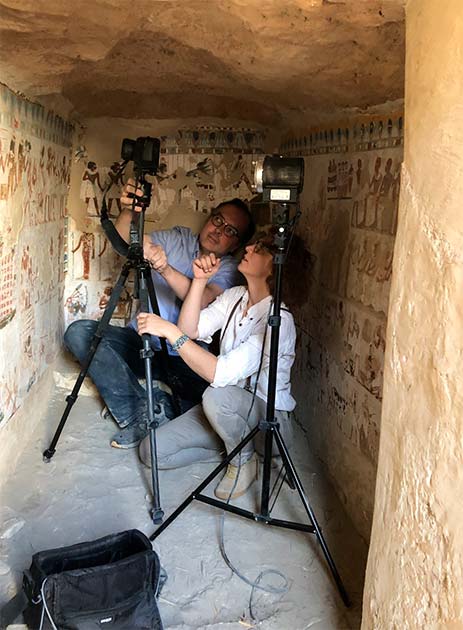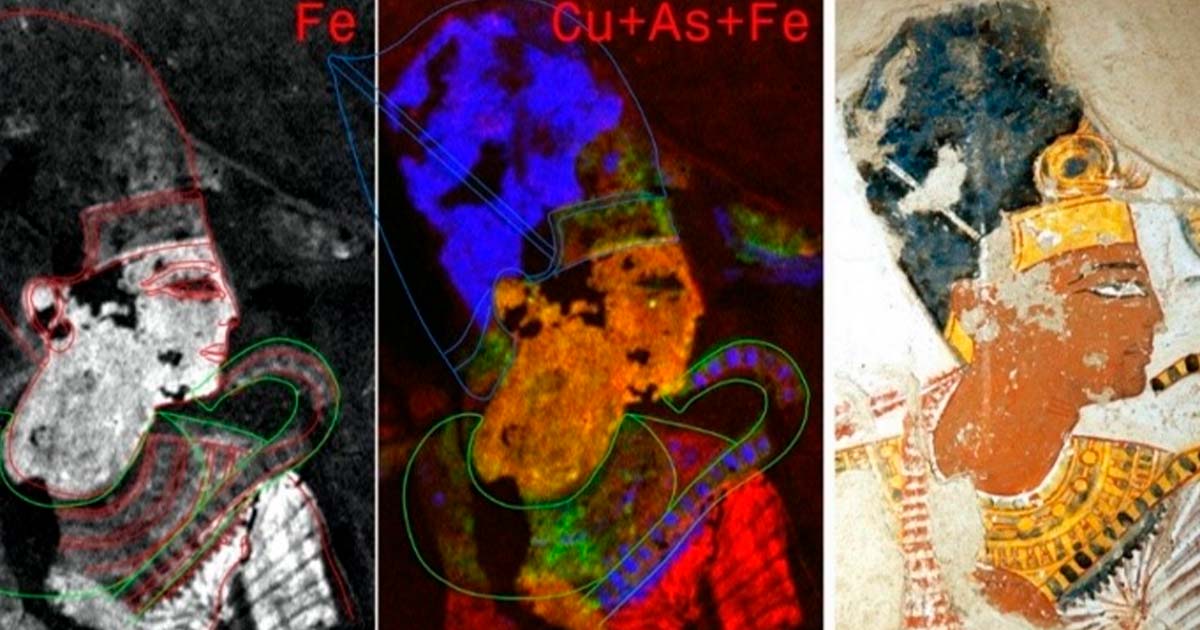New X-Ray Scanning Method Reveals Pharaoh’s Hidden Mysteries in Egyptian Paintings
Ancient photoshopping? Hidden details of ancient Egyptian paintings, along with artistic processes and alterations made to historical masterpieces over 3,000 years ago, have been uncovered by archaeologists studying ancient Egyptian paintings using portable chemical imaging technology. This technology has helped uncover, quite literally, what lies under the visible surface of a painting.
The findings, published in a groundbreaking new study in the journal PLOS ONE, focused on two paintings from the Ramesside Period (1292–1069 BC), which were discovered in tomb chapels located in the Theban Necropolis. The archaeologists from Martinez of Sorbonne University and the University of Liège have offered amazing insights into the artistic processes and alterations made to these historical masterpieces.

Portrait of Ramesses II in Nakhtamun tomb, Chief of the Altar in the Ramesseum, possibly 20th Dynasty, circa 1100 BC. (Martinez et al./CC-BY 4.0)
Groundbreaking Analysis of Egyptian Paintings
Traditionally, the analysis of ancient Egyptian paintings had been conducted in controlled laboratory environments or within museum premises. This new study has instead pioneered a groundbreaking approach by employing portable devices for chemical imaging, allowing researchers to examine the paintings in their original context. This technique enabled the team to identify alterations, layering, and paint composition while working directly in the field.

Philippe Walter and Catherine Defeyt taking measurements in the Noble Valley in Luxor (Egypt) using the portable scientific device. (David Strivay, University of Liege/ CC-BY 4.0)
This allowed the team to "discover things that were right in front of our eyes but remained unseen because of the blinkers we are wearing without knowing it," Philippe Martinez of Sorbonne University, an Egyptologist and lead author of the study, told Newsweek.
- Did the Ancient Egyptians Create Art as a Way to Manifest Reality?
- 10 Great Mysteries Hidden in Famous Paintings (Video)
To conduct the examination, the research team employed a portable version of X-ray fluorescence imaging (XRF), a technique that utilizes X-rays to analyze the chemical composition of an object. Through the application of this technology, the team scanned the painting of Ramesses II and another artwork from the same necropolis, unveiling hidden details that were imperceptible to the naked eye.
In the first painting, subtle alterations to the position of a figure's arm were detected. While the exact reasons for these modifications remain uncertain, this discovery raises intriguing questions about the artistic intentions and creative process of the ancient Egyptian painters.
The analysis of the second painting revealed a series of adjustments to the crown and other royal items depicted in a portrait of Ramesses II. These modifications likely reflect shifts in the symbolic significance of these elements over time. This finding suggests that the ancient Egyptians continuously adapted their artistic expressions to convey evolving cultural and religious ideologies.
"The Pharaonic Civilization offers the most extended cultural continuity of the ancient world. Its highly formalized painting style is easily recognized," the authors conclude.

MA-XRF study of the Egyptian painting of Ramesses II revealing hidden evolution of the painting. (Martinez et al., PLOS ONE/CC-BY 4.0)
Art History vs. Science: An Intriguing Analysis
"From the point of view of art history...these tombs have been somewhat ignored by science, as deemed of lesser quality but also because, being from the Ramesside period, their representations are mainly ritual and religious in essence. They lack the so-called 'scenes of daily life' that so entranced the lovers of Ancient Egypt," Martinez said.
The artwork is located in the tomb of Nakhtamun, an official buried near Thebes, present-day Luxor. In this depiction, the pharaoh is portrayed with slight stubble on his face, facing an indistinct figure, as revealed by the study conducted by a team of researchers, reports Live Science.
Previously, scholars speculated that the painting depicted the pharaoh grieving the loss of his father, Pharaoh Seti I, who reigned from around 1294 BC to 1279 BC. However, the latest scan of the portrait challenges this interpretation.
By employing XRF, the researchers were able to gain fresh insights into the artwork, shedding new light on its composition and potentially altering its interpretative context. This innovative scanning technique provides a non-invasive means of investigating ancient artworks, revealing previously concealed information that contributes to a deeper understanding of historical artifacts. More important, a newer and deeper understanding of the reinterpretation of Ramesses II was gained through this exercise.
“In both cases, the precise and readable imaging of the physical composition of the painted surface offers a renewed visual approach based on chemistry, that can be shared through a multi- and interdisciplinary approach. However, this also leads to a more complex description of pigment mixtures that could have multiple meanings, where the practical often leads towards the symbolic, and from there hopefully to a renewed definition of the use of colors in complex sets of ancient Egyptian representations,” write the authors of the study.
- Echoes of Eternal Egyptian Art: Masters of Form and Finesse—Part I
- 5,000 Years Ago, Ancient Scientists Used Chemical Reactions to Create Pigments in Altai Mountains
Changing the Interpretation of Ramesses II
The scan revealed that Ramesses II is positioned beneath a cult canopy, while the enthroned figure in front of him is clearly identified as the god Ptah, highlighting the significance of the relationship between the pharaoh and the deity. The scan is the depiction of Ramesses II with a protrusive Adam's apple. Remarkably, this anatomical detail is absent in most ancient Egyptian art!
Furthermore, the researchers discovered a significant alteration in the pharaoh's attire. Initially, Ramesses II was depicted wearing a "shebyu collar," consisting of voluminous chains of gold formed by large, heavy lenticular beads. However, the shebyu collar was not historically used during Ramesses II's reign, which spanned from approximately 1279 BC to 1213 BC.
Instead, it was a popular fashion choice during the 20th dynasty (c. 1186 BC to 1070 BC). The researchers found evidence that the shebyu collar had been painted over and replaced with a "wesekh" necklace, a flat piece of jewelry that was characteristic of Ramesses II's era.
"One can also note that seemingly meaningless corrections recently revealed on sculpted decoration at the Ramesseum, in places that are rather inaccessible even to the naked eye, show that we remain clearly ignorant of what was really important and significant for the ancient Egyptian eye and mind," the team concludes.
Top image: Imagery obtained from the scans of Egyptian painting of Ramesses II. Source: Martinez et al./CC-BY 4.0
By Sahir Pandey
References
Georgious, A. 2023. Mysteries of Ancient Egyptian Artworks Revealed After 3,000 Years. Available at: https://www.newsweek.com/mysteries-ancient-egyptian-artwork-revealed-after-3000-years-1812570.
Jarus, O. 2023. X-ray scans reveal 'hidden mysteries' in ancient Egyptian necropolis paintings. Available at: https://www.livescience.com/archaeology/ancient-egyptians/x-ray-scans-reveal-hidden-mysteries-in-ancient-egyptian-necropolis-paintings.
Martinez P, Alfeld M, Defeyt C, Elleithy H, Glanville H, Hartwig M, et al. 2023. Hidden mysteries in ancient Egyptian paintings from the Theban Necropolis observed by in-situ XRF mapping. PLoS ONE 18(7). Available at: https://doi.org/10.1371/journal.pone.0287647.
Milligan, M. 2023. CHEMICAL IMAGING TECHNOLOGY REVEALS HIDDEN DETAILS IN ANCIENT EGYPTIAN PAINTINGS. Available at: https://www.heritagedaily.com/2023/07/chemical-imaging-technology-reveals-hidden-details-in-ancient-egyptian-paintings/148004.
Schuster, R. 2023. Archaeologists Armed With Analyzer Change Paradigm of Ancient Egyptian Art. Available at: https://www.haaretz.com/archaeology/2023-07-12/ty-article/archaeologists-armed-with-analyzer-change-paradigm-of-ancient-egyptian-art/00000189-497b-de83-adc9-cffb3a720000.

















